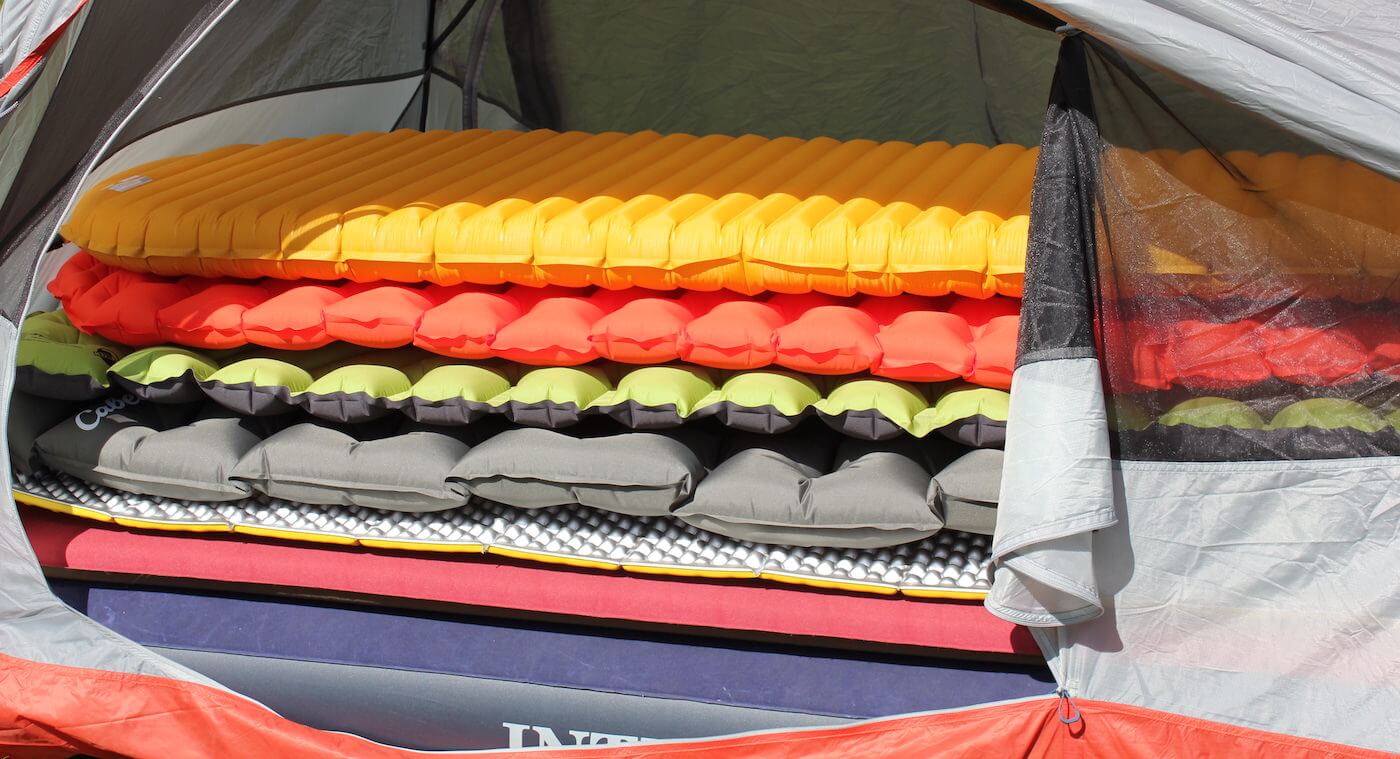The best sleeping pad for backpacking is ultralight, super cushy and insulated. There are dozens of great backpacking sleeping pads available in 2019, and as it turns out, lightweight backpacking pads make some of the best sleeping pads for camping, too. Why? Packability.
An ultralight sleeping pad works great for car camping because you can pack one down to the size of a water bottle. This means you can always toss a few sleeping pads into a go bag and throw it in the back of the SUV and take off on your next adventure. If you’re crossing a river in a raft or canoeing across a lake, smaller is better, too. Basically, any gear that reduces the time it takes to cram everything into a vehicle gains value with us — the idea is to get outside, not waste time packing bulky gear.
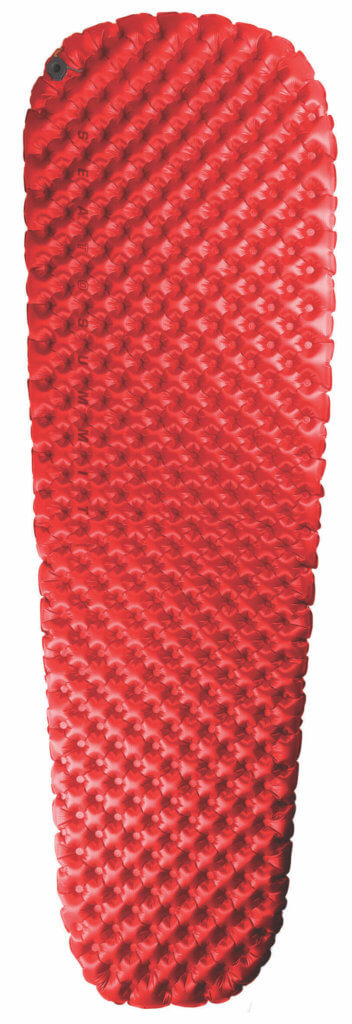
In any event, we’ll start with the 10 best sleeping pads for backpacking, then add in a few of our top recommendations for the best camping pads where cushion reigns supreme. Of course, if you’re here for the ultimate camping sleeping pads, you can skip to our best camping sleeping pads section for our favorite five.
What is the best sleeping pad?
Scroll or use the links to jump straight to our quick reviews:
3. Sea to Summit Comfort Plus Insulated Mat
4. REI Co-op Flash Insulated Air Sleeping Pad
5. Therm-a-Rest NeoAir Trekker
7. NEMO Tensor Insulated Air Pad
10. Cabela’s Ultralight Air Pad
(Full descriptions of each pad and why we recommend them are below.)
Best Sleeping Pad: Air Pads
In 2019 there is little reason to choose any sleeping pad that is not, essentially, an inflatable mattress. Air pads blow up like old-school vinyl beach air mattresses — except the ones made for backpacking and camping are far lighter and usually tougher. The best sleeping pads also have internal baffle designs that add stability as well as ensure that side sleepers don’t hit their hips on the ground.
The only downside to air pads is that if they get a hole, they fail immediately and completely. That’s why most air mattresses from reputable manufacturers also ship with repair kits. Should you worry about punctures? If you’re out in very thorny or sharp-rock areas, you’ll want to pay extra close attention to where you place your mattress. Still, punctures are not a constant concern — we have hundreds of hours into multiple inflatable sleeping pads and we’ve only had the truly cheap sleeping pads fail on us. That said, we always pack a repair kit — just in case.
In addition, you should pay attention to the material even the best ultralight sleeping pads are made from. A 20-denier (20D) nylon fabric is thinner than a 70D material. Some manufacturers will place a heavier material on the bottom with lighter material on the top. If you’re backpacking or camping with dogs, trim and file their nails before you head out — and error toward heavier fabrics.
(Of course, you can always go with an ultralight closed-cell foam sleeping pad — and we’ll tell you why when we get to it below.)
Best Sleeping Pad: Insulated vs Non-Insulated

If you’re mostly camping in the summer with warm temperatures, you don’t really need an insulated sleeping pad unless you head up into the high country where temperatures could dip down below freezing. You can save a little money if you’re primarily a fair-weather backpacker or camper and choose an uninsulated sleeping pad.
On the other hand, with today’s 2019 sleeping pads, the built-in insulation usually only adds a handful of ounces. Better yet, if you tend to be a cold sleeper, an insulated sleeping pad will make it seem as if you have a warmer sleeping bag. Because insulated sleeping pads offer the best versatility, we tend to recommend them more often.
Best Sleeping Pad: Weight
The best backpacking sleeping pads tend to weigh about a pound — 16 ounces or so. While you can find some ultralight sleeping pads that weigh even less, they tend to be smaller and lighter and are made out of thinner fabrics. It’s hard to argue that the very lightest sleeping pad is also the best sleeping pad if it’s too small and you spend too much time worrying about punctures. Sometimes the best overall value isn’t the lightest model a manufacturer produces.
Adding some insulation tends to increase the weight. A cushy and insulated air pad that weighs 24 ounces is a reasonable compromise for most backpackers — but a little heavy for a through hiker who is investing months into putting down hundreds of miles. When is a heavier sleeping pad worth it? When you need a wider, longer version. Don’t underestimate the power of a good night’s sleep.
Best Sleeping Pad: Length and Width

Most backpacking sleeping pads are 20 inches wide and 72 inches long in the standard regular size. If you’re over 6 feet tall and don’t want your feet to hang off the end, choose a longer version.
Similarly, if you’re a big guy, especially with wide shoulders, you should consider getting a wide sleeping pad. If you don’t, and you sleep on your back, your arms are going to rest on the ground at some point. The wide versions are usually 25 inches wide. If you’re camping, a 30-inch wide sleeping pad is hard not to love, but it won’t fit well when you’re sharing a two-person tent for backpacking.
Unless you’re into ultra, ultralight backpacking, we’ve found that most people do well with regular size pads but larger guys tend to rave about long and wide versions. If you’re big, the extra weight and space is probably worth a better night’s sleep. Similarly, if you’re a sprawling sleeper, go wide. And if you mostly car camp, wider is usually better because . . . why not?
10 Best Sleeping Pads for Backpacking
The top sleeping pad manufacturers all make several variations of their best sleeping pads. Some will have ultralight versions with lightweight fabrics as well as stronger versions with heavier fabrics or insulation. As we mentioned above, there are dozens of great sleeping pads — and well over ten fantastic sleeping pads. But you have to narrow the list somewhere, so these are the picks we recommend to friends and family. They offer excellent comfort, low weight, and great price-to-value ratios. And frankly, any one of them could be your own number one best sleeping pad — because hey, everyone has different sleep patterns and budgets.
1. Therm-a-Rest NeoAir XTherm
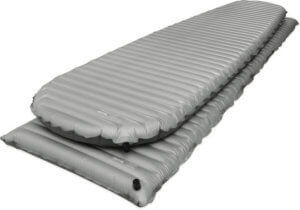
The industry leader for lightweight sleeping pads is Therm-a-Rest. The company changed the game decades ago with its self-inflating foam core pads, and now the company is offering innovation inside its air mattresses lineup, too. As an added bonus, Therm-a-Rest pads are assembled in the U.S. The NeoAir XTherm is the best sleeping pad for multi-season backpacking due to its relatively low weight, decent durability, and excellent insulation. The XTherm uses Therm-a-Rest’s Triangular Core Matrix baffled internal design, which helps provide structural stability, which also helps ensure that side sleepers don’t end up with a hip that bottoms out on the ground. In addition, Therm-a-Rest uses its reflective ThermaCapture inner reflective layers to trap radiant body heat, giving it a fantastic 5.7 R-Value. The bottom fabric is a durable 70D nylon while the top fabric is a 30D textured, no-slip fabric. It’s 2.5 inches thick. The only downside to the Therm-a-Rest NeoAir lineup is the crinkly noise the inner ThermaCapture layer can make if you roll around a lot. Most people ignore it pretty well, but if you’re a fussy sleeper — or are sleeping next to a fussy sleeper — you might want to error with a different pad. Still, the NeoAir XTherm is durable, comfortable, lightweight and awesome.
The regular is 20” x 72” and weighs just 15 oz. The L version is 25” x 77” and weighs just 20 oz. Plus, for an additional 2-3 ounces, you can choose the MAX version, which is a full rectangular shape instead of the original rounded mummy shape. Learn more: CampSaver | REI | MooseJaw | Amazon
2. Therm-a-Rest NeoAir XLite
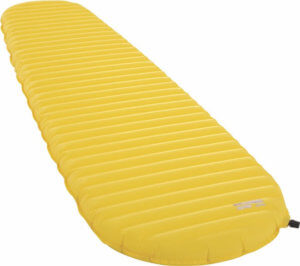
The NeoAir XLite is amazing because it delivers a solid 3.2 R-Value but only weighs 12 oz in the 20” x 72” inch size. Credit the Therm-a-Rest Triangular Core Matrix with the heat-trapping ThermaCapture lining design. The long-and-wide 25” x 77” L version weighs 16 oz, while the shorty S version is 20” x 47” and weighs 8 oz. At 2.5 inches thick, the XLite offers plenty of cushion. Like the XTherm, it’s a bit crinkly when you’re shifting around on it — fuller pressure helps reduce noise. The only major concern for most people is the fabric — the 30D nylon means you’ll need to pay more attention to avoid punctures. Of course, like the other Therm-a-Rest options, it comes with a repair kit. Oh, one more thing: It has the rounded mummy shape, not a full rectangle . . . but surprise, surprise, Therm-a-Rest now has another variation for you — the NeoAir Xlite MAX SV. This one is rectangular and includes the Therm-a-Rest SpeedValve for faster inflation. We have mixed feelings about the SpeedValve. On one hand, it’s makes inflating your sleeping pad faster, but on the other hand, some seemingly less experienced users have appeared to have a hard time understanding how to fold it up and properly seal it — or they sprang a leak and blamed it on the SpeedValve. Hard to say. Skip to the bottom to learn more about special valves and inflation tools. Learn more: CampSaver | REI | MooseJaw | Amazon
3. Sea to Summit Comfort Plus Insulated Mat
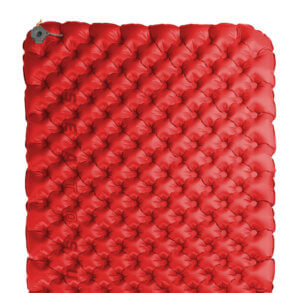
Sea to Summit is another awesome sleeping pad manufacturer that offers several excellent choices. The best, though, is the Comfort Plus Insulated Mat. Why? The Comfort Plus boasts a dual-layer construction that lets you fine-tune your cushiony experience. How? You can increase the pressure in the bottom layer to ensure that you don’t touch the ground while side sleeping while leaving the top layer with less pressure, giving you a bit more softness without the risk of bottoming out. The two layers are also offset. For insulation, Sea to Summit includes an Exkin Platinum fabric to reflect radiant heat in addition to Thermolite insulation that fights against convective heat transfer. It also has an anti-microbial treatment inside so any super tiny living things that appreciate moisture don’t find a way to grow inside. You can get this 2.5-inch thick pad in tapered or rectangular shapes, and the top and bottom fabric is a middle-ground 40D, offering reasonable durability with decent weight characteristics. The R-Value is an excellent 5.
In addition, the Sea to Summit claim to fame here is the Air Sprung Cells construction, which takes it cue from individual coil-spring mattresses. It’s designed so that it accepts pressure points while still supporting everything around the pressure point. Sea to Summit offers several versions of its air pads. Its UltraLight models are insulated or uninsulated and use single layers while its ComfortLight use dual layers only in the torso (also available insulated). The full-length dual-layer Comfort Plus offers the ultimate comfort, of course which is why it’s our top pick here. Remember that dual-layer pressurization feature? You can increase the bottom layer pressure to help smooth out small depressions underneath your pad, under your tent, which you didn’t even realize existed until 2 a.m.
The Comfort Plus Insulated Mat has several variations. The tapered Regular is 21.5” x 72” and weighs in at 27.7 oz. but you can also choose larger, smaller, and rectangular versions. The only downside is that the Comfort Plus is a bit heavier than the competition — but if you’re a fussy sleeper, it’s probably worth the fine-tuning you get from the dual-layer construction. If you like the Air Sprung Cell construction, the other versions are all lighter but still use 40D fabrics — and they’re all excellent. In fact, you could easily argue that more Sea to Summit pads should be on this list. For instance, the Regular size UltraLight is just 13.9 oz. That’s pretty damn light. Learn more: CampSaver | REI | MooseJaw | Amazon
Note: See also our review of the new Sea to Summit Ether Light XT Insulated Sleeping Mat — it’s fantastic.
4. REI Co-op Flash Insulated Air Sleeping Pad
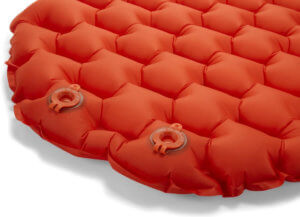
REI has been producing some very competitive new gear lately, and the Flash Insulated Air Sleeping Pad is no exception. It comes in four different sizes, Regular and Long as well as Long Wide and Regular Wide. Of course, the relatively new option of Regular Wide models means sleepers looking for more width don’t also have to carry extra length they don’t need. It has a solid R-Value of 3.7 and uses 30D ripstop nylon all around. The Regular is just 15 oz while the Long Wide only jumps up to 20 oz while giving you 25” x 78” of coverage. Instead of a single valve that you have to twist or pull to activate, the Flash uses two separate valves, one for inflation, the other for deflation. It also use a Mylar internal layer to help with radiant heat reflection. The only downside is that it’s not offered in a rectangular version — just the tapered mummy style. It is 2 inches thick. Learn more: REI
5. Therm-a-Rest NeoAir Trekker

The NeoAir Trekker is a great all-around air mattress from Therm-a-Rest. It’s not the lightest, but it’s durable, rectangular, and it will easily shift from the backpacking trail to car camping adventures. It uses the ThermaCapture lining to reflect body heat, giving the pad a 3.0 R-Value. The bottom fabric is 70D for excellent durability while the top is 30D. The NeoAir Trekker weighs in at 19 oz in the 20” x 72” size. The roomy 25” x 77” L is 24 oz, while a handy new option, the Regular Wide is 25” x 72” and weighs in at 23 oz.
But wait, there’s more — and here is where the Therm-a-Rest lineup starts to get a little confusing. The NeoAir Voyager and NeoAir Venture. Both pads cost less, weigh more, and are more durable — but they’re still great pads. If you have any concerns about durability, choose one of these pads because they use 75D fabric on both the top and bottom. The internal design is also a little different — instead of triangular baffles, the Voyager and Venture use a curvier WaveCore construction. Both pads are 2.5 inches thick and come in Regular, Regular Wide, and L options. The Regular Voyager weighs in at a respectable 22 oz, and with the ThermaCapture lining, has a 2.2 R-Value. The Venture does not have the ThermaCapture lining, so it’s a bit quieter, but the R-Value drops down to 1.8. For mostly summer backpacking and camping, it’s hard not to like the Venture, especially because it costs less than half of the NeoAir Trekker. If you’re on a budget — especially if you’re a side sleeper on a budget — try the Venture. Learn more: CampSaver | MooseJaw | Amazon
6. Big Agnes Q-Core Deluxe Sleeping Pad
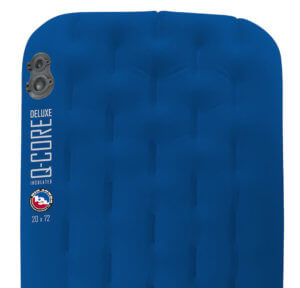
The Big Agnes Q-Core Deluxe goes all out to provide astounding comfort, stability, and a quiet experience — while also boasting a temperature rating down to 15-degrees Fahrenheit (Big Agnes doesn’t report R-Values). It’s available in 5 different rectangular sizes and is about 3 inches thick with the outer edges being a bit thicker yet. The 20” x 72” weighs 23 oz, but before you say that’s too heavy, consider the skin-comfy stretch-fabric top with a near-quilted feel. The larger outer chambers help keep you on the pad. Better yet, despite having a built-in heat reflective layer, the Q-Core Deluxe is quieter than most other pads like it. It also has PrimaLoft Silver insulation and an antimicrobial treatment inside.
The Big Agnes Q-Core SLX is a similar, lighter version but it skips the stretch-fabric top to save weight. It comes in at a competitive 16 ounces.
*Note: What about the Big Agnes Insulated AXL Air? The new AXL is super ultralight — the 20″ x 72″ mummy version weighs just 10.6 oz. Plus, it comes in a variety of ultralight sizes ranging up to a huge 25″ x 78″ rectangular version that only weighs 15.9 oz, which is just awesome. So why hasn’t the AXL earned a true spot in the top 10 on our list yet? So far early adopters have reported excellent comfort in the cushion but disappointing insulating properties, claiming they slept colder than they expected (we wish Big Agnes reported R-values). Until more people start using it and reporting their experiences, the safest bet is to nab an AXL if you primarily backpack during the summer. Of course, we’ll update this once we get a chance to try out the AXL ourselves. Learn more: CampSaver | REI | MooseJaw | Amazon
7. NEMO Tensor Insulated Air Pad

The NEMO Tensor uses a slightly different construction — it’s a whopping 3 inches thick but it doesn’t have overlapping baffles. Yet it has a sort of quilted cell shape to its construction, which aids in comfort, and the interior low-stretch fabric baffles also help keep it stable despite its height. The inside has both Primaloft insulation as well as a thermal reflective barrier. NEMO doesn’t publish an R-Value; instead, like Big Agnes, NEMO reveals a comfortable minimum temperature range. In the case of the insulated Tensor, NEMO says it’s good down to 15-degrees Fahrenheit. It’s also quieter than most other pads that also include reflective internal barriers. It’s available in a wide variety of sizes. The Regular 20R rectangular version is 20” x 72″ and uses ultralight 20D fabric, weighing in at just 15 oz. The NEMO Astro Insulated Lite comes in a close second to the Tensor. The Astro also comes in several different versions. Key differences include a more horizontal baffle design, no reflective layer inside (uses Primaloft insulation), and a slightly raised baffle at the head, which is great for back and side sleepers but might annoy stomach sleepers. The non-Lite Astro version uses 75D fabric if you’re looking for a bit more durability and a lower price. Learn more: CampSaver | REI | MooseJaw | Amazon
8. Klymit Static V2
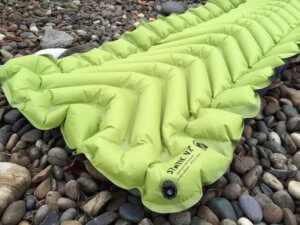
The Klymit Static V2 offers one of the best overall values in a low-cost air sleeping pad while also delivering a quality construction. Its shape is radically different from most other sleeping pads: It uses V-shaped central chambers with side rail cushions that limit air flow while also helping you stay put in the middle of your pad. It works pretty well, and while we find it plenty comfortable — we’ve only used it when we’ve been exhausted — the general consensus seems to be that the pads noted above tend to be more comfortable to more people. A key potential issue is the gaps between the baffles. If you’re a side sleeper, you might end up with your hip between a baffle and bottom out. On the other hand, those gaps were designed to let your sleeping bag fill out the voids, letting your sleeping bag provide better insulating properties: If your down sleeping bag is compressed under you, for example, it’s not keeping your under side warm. The challenge is having a high loft bag where this might actually work — and then knowing if it’s doing you any good or not. Hard to say, but for warm weather backpacking and camping, the pad packs down small, is competitively light, and it starts out at a whopping 23 inches wide. There is a lot of value here, especially in those three extra width inches. On more than one occasion we’ve considered buying several just to use on family camping outings because the overall price-to-value ratio is so good and it packs down so small. The Static V2 is 23” x 72” and 16.33 ounces with a 30D top and a 75D bottom. The R-Value is just 1.3, but the Insulated Static V Lite has a 4.4 R-Value and comes in at just 19.6 oz — the only trouble with the insulated version is that its higher price means Klymit loses the insanely good competitive edge on price for the uninsulated Static V2. Learn more: CampSaver | MooseJaw | Amazon
9. Exped SynMat UL

Exped manufactures dozens of great sleeping pads. Most of Exped’s lightweight air pads feature longitudinal tube-like baffles. The tubes have an old-school vibe, but the overall tech is anything but. The SynMat UL is a cushy 2.8 inches thick and weighs just 16.8 oz in the 20.5” x 72” rectangular size. It has a respectable 3.3 R-Value and uses a lightweight 20D fabric. And speaking of the fabric, the top has Exped’s anti-slip GripSkin honeycomb-pattern coating, which is good for wild sleepers and those who have a hard time finding a level spot to pitch their tent.
If you want a similar overall design but would prefer a heavier fabric, consider the SynMat 7 M — it uses a stout 75D fabric and includes a built-in pump for inflating, which means you’re not adding any moisture from your own breath. Learn more: MooseJaw | Amazon
10. Cabela’s Ultralight Air Pad
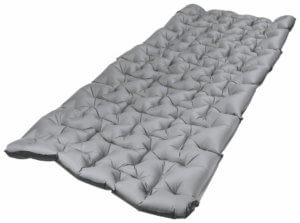
Cabela’s is more known for its camping and hunting gear than its backpacking gear, but Cabela’s has been doing some great work creating solid backcountry designs offered at compelling pricing. The Cabela’s Ultralight Air Pad lacks a wide variety of different versions — it comes in just two sizes. The 23” x 72” is a respectable 18.5 ounces (which is great when you consider you get three more inches of width than the standard 20-inch pad.) All of this makes it compete particularly well with the also affordable Klymit Static V2. The large is just under 2 lbs, but it is a luxurious 30 inches wide and 78 inches long — great for big or sprawling sleepers. It features rugged 75D fabric and is 2.5 inches thick. The R-Value is just 1.2, so it’s best for summer use. One more thing: These pads come with Cabela’s Lifetime Guarantee. Learn more: Cabela’s
Runner-Up: Best Closed-Cell Foam Sleeping Pad

Therm-a-Rest Z-Lite SOL — The Therm-a-Rest Z-Lite SOL is not an air pad — and it’s not a more traditional self-inflating pad, either. The Z-Lite SOL is a closed-cell foam pad, which means you don’t blow it up and it will never pop. In fact, it’s not only ultralight, it’s ultra durable. And that’s its charm — durability. The Z-Lite uses a bunch of dimples that trap heat but also nest together when you fold it up, accordion style. The Z-Lite SOL includes a ThermaCapture coating to help reflect your body heat. It has an R-Value of 2.6. The Regular is 20” x 72” and weighs just 14 oz while the small is 20” x 51” and weighs just 10 oz. Any downsides? It doesn’t pack down as small as air pads and it’s not nearly as comfortable. But if you’re dog tired and you’re not fussy, it works great.
On a side note, we actually like to pack along a short closed-cell foam pad to use as a seat outside in the dirt, rock and rain — in addition to an inflatable air pad. (Just because we’re backpacking 30 miles from pavement doesn’t mean we don’t like creature comforts, so it’s worth the extra weight to us.) Closed-cell foam sleeping pads like this are also handy when you’re stuck on sloping tent site — you can fold it to prop up under your air pad to give you a more level bed. In any event, the Therm-a-Rest Z-Lite SOL is the best of the closed-cell foam options, and it’s super versatile. Learn more: CampSaver | REI | Amazon
Still Need Help Choosing the Best Sleeping Pad for You?
If you’re a little dizzy with all the great choices, choose the Therm-a-Rest NeoAir XTherm because it’s lightweight but also provides excellent insulation. If you’re a sleeper worried about any noise, try the Big Agnes Q-Core Deluxe. If you’re on a tight budget but still want all the goodness of an air mattress, both the Klymit Static V2 and Cabela’s Ultralight Air Pad are pretty darn good while coming in at fantastic price points.
Best Sleeping Pad for Winter Camping
The best sleeping pad for winter backpacking is a highly insulated sleeping pad, and you may even want to take along a closed cell foam pad, too. Winter backpacking and camping requires a whole different level of thought and commitment — and it usually means that buying a four-season sleeping pad and/or four-season sleeping bag and/or four-season backcountry tent results in a lot of extra weight you don’t need for 75 percent of the year. If you really want a 4-season pad, you want a high R-Value pad of at least 5 or so, and even then you should consider augmenting it with a closed-cell foam pad to go underneath, for both extra coverage as well as emergencies if you develop a leak. You’ll be sleeping on snow, and trying to make a patch work in below freezing conditions could be difficult.
Camping Mattresses vs. Sleeping Pads: Our Favorite 5

There’s a huge blurry mess around how the sleeping pad/mattress industry describes sleeping pads and so-called mattresses. Case in point? Therm-a-Rest and Sea to Summit call their ultralight air pads mattresses. We tend to think of them as sleeping pads even if they are 3 or 4 inches thick. Some places make a distinction between thinner self-inflating sleeping pads vs mattresses, where mattresses are usually any air pad that’s more than two inches thick. The point is, as you’re looking to find your own best sleeping pad, mattress pad, or sleeping mat, don’t get hung up on the terms because there is still a lot of variations in how the descriptions are thrown around.
Of course, the best camping mattresses warrants a whole separate guide, but if you’re considering a camping mattress upgrade that still remains relatively lightweight, these are our current favorites:
1. Therm-a-Rest NeoAir Dream
This system includes a NeoAir mattress that goes inside a luxury fabric case with a foam core as part of the cover. When you’re ready to go light, remove the inner NeoAir. Best of two worlds.
2. REI Co-op Relax Air Bed
It’s a big queen-size air mattress with lots of cushion and great quality.
3. Klymit Double V Camping Sleeping Pad for Two
Usually we think it’s a smarter plan to just buy two single-person Klymit V2 sleeping pads, but there is something to be said for actually sharing the same sleeping pad or air mattress with your significant other. Separate pads can shift and leave you on the cold ground, and because you’re sleeping next to someone else, probably in a double sleeping bag, you very likely won’t fix the errant sleeping pad so you don’t disturb your partner. The answer, of course, is the Klymit Double V Camping Sleeping Pad for Two, which also comes in an insulated version. It’s made from durable 75D polyester, so it should be able to handle most camping environments with ease, plus its stuff sack doubles as a pump bag to make filling this double sleeping pad much easier. One last note: The V-chamber design reduces air movement between the sides so if your partner tosses and turns, you might be able to sleep through it.
4. Exped Comfort Megamat 10
Extra long, extra wide, lots of cushion and fantastic quality.
5. Intex Prestige Downy Air Bed
It’s big, offers lots of cushion, and its price point is crazy low . . . but it’s of a lessor quality. Still, the value of the Intex mattress lineup is fantastic (and the Intex rafts are pretty astounding, too). Most everyone we know has a couple variations of Intex mattresses just in case the nieces and nephews need a place to crash over the holidays. Note: Buy an extra one to have as a backup when the first one eventually fails — you can do it because they’re so affordable.
Backpacking Sleeping Pads: Integrated Pumps & Special Valves

Some of these manufacturers have created special versions with built-in foot pumps or special “speed” valves. In our view, they’re not truly necessary, add weight, and they add complexity for possible points of failure or slow leaks . . . but they’re not exactly bad, either. The trouble with most of them is user error. For instance, Therm-a-Rest has seen some complaints over its SpeedValve option, but there’s a good chance many of these complaints come from people not properly folding the valve or even closing the smaller valve. Hard to say for sure, but the type of seal in the SpeedValve is the same sort of fold technique used with dry bags — and it’s worked well for years.
Exped has some built-in pumps, and while they work pretty well, they add a few ounces of weight. Is picking up a pump system worth it? If you backpack frequently or change campsites several times during a week-long outing, we think so, if only to reduce blowing moisture into your air mattress. If you’re family camping and are stuck blowing up six sleeping pads . . . a good pump or bag pump is definitely worth it.
Here are some options to consider:
- Therm-a-Rest NeoAir Torrent Pump
- Therm-a-Rest NeoAir Mini Pump
- Therm-a-Rest NeoAir Pump Sack
- Sea to Summit Air Stream Dry Sack
- Seat to Summit Jet Stream Pump Sack
- Big Agnes Pumphouse Ultra
- REI Co-op Stratus Sleeping Pad Air Pump
- Exped Schnozzel Pumpbag
- Klymit Rapid Roll-Top Air Pump
Whichever pad you choose, odds are you can find a compatible pump or pump bag system to help you inflate it.
Sleeping Pad Chairs and Other Accessories
In addition to special pumps and sack pumps, some sleeping pad manufacturers make their own accessories. Case in point? Lightweight fabric kits for transforming sleeping pads into lounger sort of chairs. Some also offer fitted sheets, which are particularly great for hot summer nights where you use your sleeping bag zipped open like a quilt.
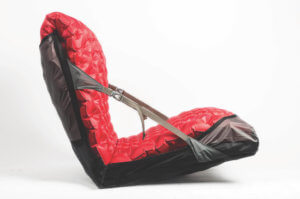
Sea to Summit Air Chair — Just 8 ounces of kick back awesomeness.
Therm-a-Rest Trekker Chair — Redesigned in 2017, the Trekker Chair weighs only 10 ounces.
Big Agnes Big Easy Chair Kit — 14 ounces.
Sea to Summit Coolmax Fitted Sheet — 5 ounces.
Klymit V Sheet — 5.6 ounces.
Exped Pillow Pump — Pretty ingenious, really, and just 4.9 ounces.

